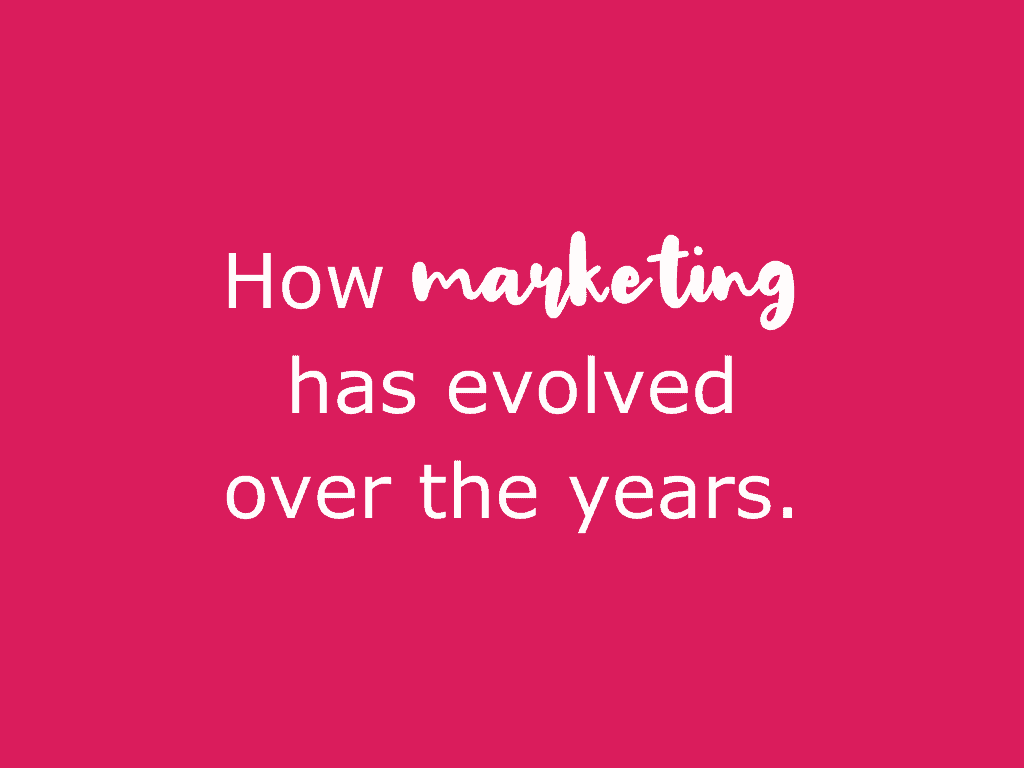
How Marketing Has Evolved Over the Years
How Marketing Has Evolved Over the Years
Marketing is a solution no business should be without. In fact, at the centre of every organisation – whether profit or non-profit – lies a solid marketing strategy. Marketing enables your business to get the word out there about their products or services and wider brand. It also allows leads to be generated and nurtured to win new and repeat business from your target market.
At a more basic level, marketing informs and educates customers, and evens the playing field amongst businesses big and small. It builds and helps to sustain your brand identity, facilitates that all-important engagement, and gives you the means to grow your company from the roots up.
Combining sales, promotions, public relations and advertising, and encompassing a business’ long and short term ambitions, no two marketing strategies are the same. Yet it’s evolving trends and techniques that make marketing plans the pioneering, hard-hitting solutions they’re meant to be. Like all industry sectors, the marketing world is ruled by the ups and downs of the latest advancements, which can make the practice seem more modern than it is.
The very beginnings of marketing however stretch back hundreds of years. Let’s look at how this age-old practice has evolved ever since.
The dawn of the print era
Print marketing has no doubt been in decline in recent years but it was the invention of the moveable type that saw the first inklings of modern marketing as we now know it. The invention of Gutenberg’s moveable type printing press triggered the very start of the print advertising era, but contrary to popular belief, this pioneering piece of technology wasn’t a world-first.
The world’s first moveable type was made of porcelain, not metal, and was invented in 1040 AD in China. Back then it was used to print paper books. Johannes Gutenberg’s metal type however provided a more efficient, mass production technique that ushered in the information revolution along with early advertising practices.
The Bible was the first book Gutenberg printed, but his technology was quickly applied in other areas. Just a short time later, the UK’s first printing enterprise was founded off the back of Gutenberg’s tech, but it wasn’t until some 255 years later that the first modern magazine was printed.
The Gentlemen’s Magazine was published to great acclaim right up until 1914. This publication was initially created for entertainment purposes with its essays, stories, poems and commentary providing a little respite from the issues of the day.
Just over a decade later, a year after America’s first magazine went to press, the first magazine advertisement was printed.
Marketing in the mainstream
Print advertising rapidly evolved over the next century, and with the rise of magazine advertising came the emergence of marketing materials in the public domain.
Magazines were often regarded as a material only accessible to the privileged, educated classes, yet the explosion of poster use in the 19th century consolidated the power of marketing to all, rich and poor.
By 1839, posters became so popular that they were actually banned from being used on private property in London. Years later, the latest marketing advancements saw the very first cases of unsolicited advertising spam (yes, they used this term even back then!) when a telegram message containing an advertisement that wasn’t requested was sent out to the masses.
The power of marketing to the masses became undeniable, which meant advertisements got bigger and bigger. After the first recorded use of mass unsolicited spam came the very first billboards with the earliest rentals going back as far as 1867.
With companies now fully on display, the first examples of trademarks as branding followed. The legal protection of business names was done for exactly the same reason as it is today – to ensure trust amongst consumers.
There are new mediums in town
Whilst print advertising remained a firm favourite into the 20th century with brands looking to market their wares and customers looking to procure their products or services. Evolving technology meant that new mediums could be developed, mediums that would change the landscape of marketing for good.
The history of radio may go back to the 18th century but its development in the 1920s made the introduction of radio advertising possible.
Radios, and the catchy commercial jingles they aired, became fixtures in many people’s homes all around the world. That was until the invention of the television. The emergence of another medium unlocked many more marketing opportunities. The first TV advertisement was aired in 1941, with the ground-breaking, 10-second-long commercial for watchmaker Bulova reaching 4,000 households in the US and costing just $9!
There were yet more mediums to move into the mainstream, and as the use of telephones in households increased, the telemarketing practices many of us despise today became commonplace.
Multimedia is vital to successful marketing in the modern-day, with many brands relying on a mixed media bag to achieve their own unique marketing objectives. The introduction of these new technologies consolidated the importance of multichannel marketing. As more and more mediums create more marketing opportunities, however, the outlets of yesteryear were falling by the wayside.
By 1972, the popularity of radio advertising, TV advertising and telemarketing saw the start of the decline of print media, with even popular titles, like Life magazine, closing their doors for good after decades of success.
And so comes the digital age
The invention of personal computers, the internet and handheld mobile phones changed it all. The 1970s was a particularly pioneering time and is credited with being the very start of the digital age of marketing. But the emergence of new tech didn’t mean the death of TV advertising.
Savvy inventors used TV advertising to strengthen their brands. The invention of the first personal computer by IBM Corp. for example paved the way for the first Apple Macintosh and one very expensive TV advertisement to promote it!
In 1984, the launch of the Macintosh was announced with a Super Bowl ad. The commercial was directed by renowned film director and producer Ridley Scott and cost $900,000 to create. The ad reached nearly half of all households in the US however making it a huge marketing success despite its astronomical cost.
You may think that the introduction of computers would have finished print media off for good, but it actually provided a much-needed boost for the print industry. Print advertising was made easier thanks to the personal computer and desktop publishing, and newspaper advertising became a billion-dollar industry as a result. It wasn’t until a decade later that the use of TV as a marketing medium overtook print.
Search marketing was born
The 1990s was another interesting era for marketers and a period of great transition. Search marketing was born with the launch of Yahoo! and AltaVista changing the marketing world. As the number of people using the web and searching gradually increased, the need for search engine optimisation became apparent and so started the snowball effect.
In 1998, Google launched and just two years later Pay Per Click (PPC)/AdWords was founded. It wasn’t until another five years later that Google Analytics arrived. Blogging, the use of inbound marketing techniques and social media quickly followed with LinkedIn launching in 2003 and Myspace in 2004.
With all these advancements, techniques such as telemarketing quickly faltered with many consumers wising up to these practices. But for all the marketing opportunities lost by the establishment of the US’ National Do Not Call Registry and the UK’s Telephone Preference Service (TPS), came more prospects thanks to the development of email marketing, social media, real time search, ecommerce and smartphone usage.
Marketing will continue to evolve, in fact, we see changes and emerging techniques almost daily! Keep your business ahead of the curve with a little help from our full service digital marketing agency.

